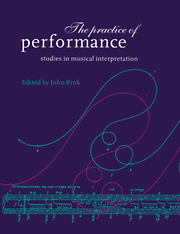Book contents
- Frontmatter
- Contents
- Preface
- PART ONE FUNDAMENTALS
- PART TWO STRUCTURE AND MEANING IN PERFORMANCE
- 5 The conductor and the theorist: Furtwängler, Schenker and the first movement of Beethoven's Ninth Symphony
- 6 A curious moment in Schumann's Fourth Symphony: structure as the fusion of affect and intuition
- 7 Beginning–ending ambiguity: consequences of performance choices
- 8 Strategies of irony in Prokofiev's Violin Sonata in F minor Op. 80
- PART THREE PERFORMANCE AS PROCESS
- Index
5 - The conductor and the theorist: Furtwängler, Schenker and the first movement of Beethoven's Ninth Symphony
Published online by Cambridge University Press: 10 October 2009
- Frontmatter
- Contents
- Preface
- PART ONE FUNDAMENTALS
- PART TWO STRUCTURE AND MEANING IN PERFORMANCE
- 5 The conductor and the theorist: Furtwängler, Schenker and the first movement of Beethoven's Ninth Symphony
- 6 A curious moment in Schumann's Fourth Symphony: structure as the fusion of affect and intuition
- 7 Beginning–ending ambiguity: consequences of performance choices
- 8 Strategies of irony in Prokofiev's Violin Sonata in F minor Op. 80
- PART THREE PERFORMANCE AS PROCESS
- Index
Summary
Among the many hats worn by Paul Henry Lang was that of record critic for High Fidelity magazine. Writing in the late 1960s, Lang was an early proponent of what might nowadays be called modernist performance. So it is not surprising that he reserved some of his most vitriolic comments for Wilhelm Furtwängler, the great exponent of the Wagnerian tradition of conducting, who had died in 1954 but whose recordings were still available at the time. According to Lang (1978: 17), Furtwängler was ‘a dyed-in-the-wool romantic, favoring arbitrary and highly subjective procedures in tempo, dynamics and phrasing’. And he wrote of the most famous of all Furtwängler's interpretations, the 1951 recording of Beethoven's Ninth Symphony, that it is a ‘stereo “reconstruction also playable on mono”, but it does not make any difference how you play it. This recording, with the Bayreuth Festspielhaus forces, is something of a treasured antique, though I can't see the reason for the admiration’ (: 24). At best, Lang concluded, Furtwängler's recordings of Beethoven were ‘for collectors and historians, not for enjoyment’ (: 17).
As might be expected, Lang's characterisation of Furtwängler is blatantly contradicted by enthusiasts like Peter Pirie, the author of a book on Furtwängler's recordings. For Pirie, the way Furtwängler performed Beethoven was anything but arbitrary; on the contrary, says Pirie (referring specifically to the first movement of the Ninth Symphony), ‘his interpretation analyzed the structure’ (1980: 49).
- Type
- Chapter
- Information
- The Practice of PerformanceStudies in Musical Interpretation, pp. 105 - 125Publisher: Cambridge University PressPrint publication year: 1995
- 10
- Cited by



